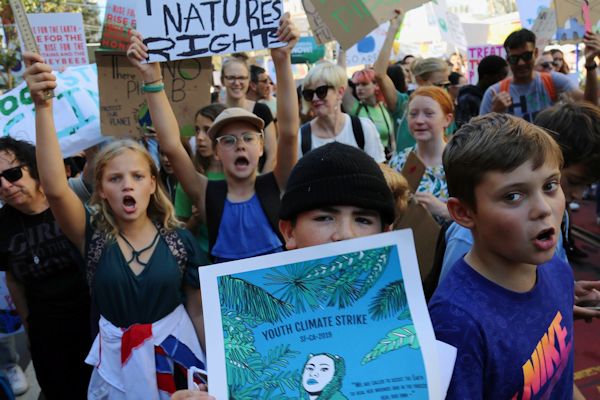SEJournal Online is the digital news magazine of the Society of Environmental Journalists. Learn more about SEJournal Online, including submission, subscription and advertising information.
 |
| Local groups of young climate activists are moving the dial on the issue as Election Day approaches. Above, a group of youth protesting in San Francisco on Sept. 20, 2019, as part of a global climate strike. Photo: Fabrice Florin, Flickr Creative Commons. Click to enlarge. |
Reporter’s Toolbox: Youth Activist Groups Push Climate Into Voting Booths
By Joseph A. Davis
As the Nov. 3, 2020, election takes final shape, it is already clear that young people, especially climate activists, will play an influential role, aiming to and often succeeding at upsetting apple carts. That’s news for environmental journalists when it happens.
They proved it on Sept. 1 when they delivered a decisive 11-point Democratic primary win for Sen. Ed Markey of Massachusetts. Markey had faced a stiff challenge from Rep. Joseph Kennedy III. Markey overcame Kennedy’s early lead in some polls largely by virtue of help from legions of young activists.
It was Markey’s stance on climate (i.e., cosponsoring the Green New Deal with Rep. Alexandria Ocasio-Cortez, D-N.Y.) that was a key in winning their help. One focus of that organizing muscle was the Sunrise Movement, the same young guns who had boosted Ocasio-Cortez to her upset victory (may require subscription) over veteran Joseph Crowley in 2018.
Youth climate activists also take the field this fall fresh from what some consider another victory, this one at the Democratic National Convention. They had a big influence (though they would say not enough) on the DNC platform and on the platforms of presidential and vice-presidential candidates Joe Biden and Kamala Harris.
Tap into local chapters
One way for environmental reporters to gauge how the environment will impact the election is to check in with some of these youth climate groups. They often work via state or local chapters — and that helps you localize the story.
Find your local groups and then find out what candidates they are supporting or opposing. Here’s a starting list for your reporting toolkit:
- Sunrise Movement: This youth-led, climate-focused grass-roots group is the one which brought you AOC and the Green New Deal. It has been broadening its reach to build chapters across the country. It is also active in national policy debates, such as the one over the Democratic platform.
- Fridays for Future: Originally, there was just one striker who demonstrated outside the Swedish Parliament instead of going to school on Fridays: Greta Thunberg. Then her lone action grew into an international movement, also known as School Strike for Climate.
- U.S. Youth Climate Strike: Justice-focused and openly anti-capitalist, this group is the U.S. outgrowth of School Strike for Climate. It’s active in elections and chapter-based.
- Zero Hour: This youth-led group (one leader is Jamie Margolin) focused on the countdown to a 12-year deadline for climate action. Its structure includes chapters.
- SustainUS: Another youth-led climate group, this one focused on the 2019 United Nations Climate Summit and its outgrowths, including international deliberations via U.N. agencies.
- Uplift: This youth community organizes around climate issues on the Colorado plateau and the Southwest United States.
- 350.org: This group was started by writer Bill McKibben, who has left it to younger leaders. The number 350 refers to preindustrial CO2 concentrations. It’s proven very effective and is international in scope, as well as chapter-based.
- Future Coalition: Not just an activist group, this group is more of an incubator and toolbox for youth activist groups focused on climate.
- Defend Our Future: This youth-focused spinoff of the Environmental Defense Fund, an established environmental group, is aimed at fostering bipartisan, or nonpartisan, clean energy solutions.
- American Conservation Coalition: This group is different because, while nonpartisan, it comes at the climate issue from a “market-based” and limited-government perspective. It is very much youth-oriented.
- University Divestment Campaigns: Many major universities and colleges are seeing divestment campaigns — movements urging the school to remove the investments in its endowment from fossil fuel companies. One recent high-profile case involved an insurgent campaign winning board of overseer seats at Harvard University. Check locally, but there are many such campaigns. There are other divestment movements, but the ones at universities are where you find youth climate activists.
The above are not all the youth climate groups, of course, just some of the major ones with large geographic reach. You should definitely look around for others that may be concentrating on your area or region — or may not be exclusively youth-based. You can find all kinds of other groups listed as members of the Climate Action Network.
It is worth remembering that there are a lot of other climate groups — other groups that will be working hard on climate issues in the November 2020 election. Those listed are just some of the youth-oriented ones. But they will be important because they release the huge and growing energy source that is youth activism.
Joseph A. Davis is a freelance writer/editor in Washington, D.C. who has been writing about the environment since 1976. He writes SEJournal Online's TipSheet, Reporter's Toolbox and Issue Backgrounder, as well as compiling SEJ's weekday news headlines service EJToday. Davis also directs SEJ's Freedom of Information Project and writes the WatchDog opinion column and WatchDog Alert.
* From the weekly news magazine SEJournal Online, Vol. 5, No. 32. Content from each new issue of SEJournal Online is available to the public via the SEJournal Online main page. Subscribe to the e-newsletter here. And see past issues of the SEJournal archived here.

















